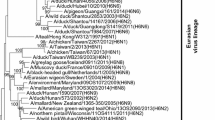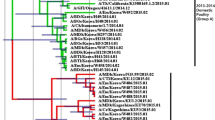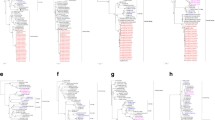Abstract
Aquatic birds are a reservoir of all known influenza A viruses. Avian influenza viruses have played a major role in the creation of pandemic influenza viruses in humans. In this study, we genetically characterized genes of nine isolates from waterfowl in Eulsukdo, a congregating place for migratory birds on the flyway of migration from Siberia, which is located in the southern part of South Korea. Phylogenic analysis showed that HA and NA genes of isolates belonged to Eurasian lineage, and lineage analysis showed that NS, PB1, PA, NP, and M genes of isolates clustered with Eurasian lineage, and PB2 genes of isolates belonged to North American or Eurasian lineage. Results suggest that the interregional transmission of genes of avian influenza viruses may occur in the migratory birds.
Similar content being viewed by others
Wild birds serve as a reservoir for all known influenza A virus subtypes including 16 hemagglutinin (HA) and 9 neuraminidase (NA) subtypes [1]. From wild aquatic birds some subtypes of avian influenza viruses have been transmitted to domestic poultry and humans. Avian influenza viruses preferentially infect cells in the gastrointestinal tract of wild ducks, are mainly excreted in feces, and are transmitted through fecal-oral route among wild aquatic birds [2]. It is generally accepted that avian influenza viruses cause asymptomatic infections in the wild aquatic birds. However, highly pathogenic H5N1 influenza viruses caused the deaths of migratory birds in the Western China in 2005 [3–5]. From May to June 2005 thousands of aquatic birds died of infections of highly pathogenic H5N1 influenza viruses in Lake Qinghaihu, Gangcha County, Qinghai Province, in the Western China. Lake Qinghaihu is known as one of the breeding places for migratory birds that overwinter in Southeast Asia, Tibet, and India. The outbreak of H5N1 viruses in migratory birds suggests that the migratory birds may have played a role as a spreader of highly pathogenic avian H5N1 influenza viruses.
Avian influenza viruses have played an important role in the creation of pandemic influenza viruses in humans. Most genes of 1918 pandemic H1N1 influenza that caused mortality of 20–50 million people were of avian origin [6], though another study raised the possibility of HA recombination between human and swine origins [7]. Avian HA, NA, and PB1 genes and avian HA and PB1 genes contributed to the creation of 1957 (H2N2) and 1968 (H3N2) pandemic influenza viruses, respectively [8–10]. At the present time, avian H2, H5, H6, H9, and H7 subtypes of influenza viruses are regarded as potential viruses for next pandemics in humans [11–13].
Thousands of migratory birds congregate on Eulsukdo in the southern part of South Korea on the migration flyway from Siberia every year. Every year thousands of migratory birds including Eurasian wigeon (Anas penelope), bean goose (Anser fabalis), and whooper swan (Cygnus Cygnus) visit Eulsukdo. In this study, we collected 1,000 fecal samples of waterfowl on Eulsukdo from November to December 2006, isolated nine avian influenza viruses by inoculation of fecal samples into specific pathogen free (SPF) eggs, and genetically analyzed the isolated avian influenza viruses.
The samples were collected using swabs in 1 ml of isolation media, PBS (pH 7.4) supplemented with glycerol, Potassium penicillin, Streptomycin sulfate, Gentamicin sulfate, Polymixin B, and Nystatin, and were directly shipped to our laboratory for the isolation of avian influenza viruses. The samples from the migratory birds were filtered using 0.22 μm syringe filter (Millipore Corporation, USA) before they were (200 μl per egg) inoculated into 10-day-old SPF eggs. The inoculated eggs were incubated at 37°C for 48 h, and then were chilled at 4°C for 12 h before allantoic fluids were tested for the presence of viruses by hemagglutination assay (HA) using 0.5% turkey red blood cells. Six out of nine isolates were from samples collected in November 2006.
Viral RNA was extracted directly from allantoic fluids of HA-positive samples using the Rneasy Protect Mini Kit (Qiagen, Valencia, CA, USA). The RNA was transcribed into cDNA using the ImProm-II TM Reverse Transcription System (Promega, Madison, WI, USA) by using the Uni12 primer (AGCAAAAGCAGG). cDNA was amplified with GoTaq DNA Polymerase (Promega, Madison, WI, USA) and segment-specific primer sets. The sequences of these primers are available upon request. PCR products were purified with the QIAquick Gel Extraction Kit (Qiagen, Valencia, CA, USA) and directly sequenced by Genotech copoporation, Daejeon, Korea. DNA sequences were compiled and edited with the Lasergene sequence analysis software package (DNA Star software version 4.0, Madison, WI, USA).
Phylogenic analysis was performed by analyzing the data of our isolates with those of sequences of influenza viruses obtained from the GenBank database by Neighbor joining trees and MEGA4: molecular evolutionary genetics analysis (MEGA) software version 4.0. The nucleotide regions used in the phylogenic analyses were PB2: 450–2170, PB1: 1–920, PA: 1120–2150, HA:1–974, NP: 40–510, NA:1–1082, M: 1–600, and NS: 1–890.
The nucleotide sequences obtained in our study are available in GenBank under accession numbers: PB2 (EU239861–EU239868, EU239849), PB1 (EU239879–EU239887), PA (EU239870–239879), HA (EU249363–EU249370, EU239833, EU313769), NP (EU239843–EU239851), NA (EU239824–EU239830, EU263337–EU263338, EU313770), M (EU239834–EU239842), NS (EU239852–EU239860).
We performed phylogenic analysis of HA and NA genes of our isolates from waterfowl with known sequences of HA and NA genes in GenBank to understand the relationship among influenza viruses. When we compared HA and NA genes (Table 1), HA and NA genes of all isolates belonged to Eurasian lineage. We grouped lineages based on the location where influenza A viruses were isolated. When we compared HA cleavage sites of our isolates, none of our isolates contained polybasic amino acids in the cleavage sites that would indicate the highly pathogenic property of avian influenza viruses (data not shown).
Zanamivir and oseltamivir were used to treat humans infected with influenza viruses in various parts of the world between 1999 and 2002. These drugs act by inhibiting NA activity that prevents the release of progeny virions from infected cells. Mutations in the NA causing resistance to oseltamivir have arisen in patients infected with influenza viruses [14, 15]. Resistance viruses had mutations in E119 V, H274Y, or R292 K in NA genes. When we analyzed these positions in NA genes of our isolates none of isolates contained mutations responsible for NA inhibitors (data not shown).
Influenza A viruses express a nonstructural protein 1 (NS1 protein) in infected cells that counteract anti-viral action by IFN-α/β [16]. When we compared NS genes of our isolates with known NS genes available in GenBank (Table 1), all isolates belonged to Eurasian lineage. All M, NP, PA, PB1, and 8 PB2 genes of our isolates belonged to Eurasian lineage and one PB2 gene of our isolates belonged to North American lineage (Table 1). Results suggest that genes of our influenza viruses isolated from waterfowl belong to different lineages even within each virus particle.
Aquatic birds are a natural reservoir of influenza A viruses [2]. Avian influenza viruses are in equilibrium with aquatic birds and do not cause clinical signs in hosts. However, in 2005 the outbreak of highly pathogenic H5N1 influenza viruses in migratory waterfowl occurred in the Qinghaihu lake region of the Western China [3, 4]. In this study, we genetically characterized avian influenza viruses isolated from Eulsukdo, one of the largest congregating places for migratory birds in South Korea. The isolates are composed of multiple constellations of genes that belong to different lineage.
Lineage analysis of our isolates showed that NS, PB1, PA, NP, and M genes clustered with Eurasian lineage, and PB2 genes clustered with Eurasian, or North American lineage (Table 1). The results suggest that interregional transmission of the internal protein genes of influenza viruses may occur between Eurasian and North American lineages. The study on internal protein genes of H2 avian influenza viruses in migratory ducks that congregate in Hokkaido, Japan, on the flyway of migration from Siberia showed that PB2 genes of DK/Hokkaido/107/01 (H2N3) and PA gene of DK/Hokkaido/95/01 (H2N2) belonged to the American lineage of avian influenza viruses [17]. Interregional reassortment among genes of avian influenza viruses may occur when some migratory birds cross the Atlantic after North–south migration
References
R.A. Fouchier, V. Munster, A. Wallensten, T.M. Bestebroer, S. Herfst, D. Smith, G.F. Rimmelzwaan, B. Olsen, A.D. Osterhaus, J. Virol. 79, 2814–2822 (2005). doi:https://doi.org/10.1128/JVI.79.5.2814-2822.2005
R.G. Webster, W.J. Bean, O.T. Gorman, T.M. Chambers, Y. Kawaoka, Microbiol. Rev. 56, 152–179 (1992)
H. Chen, G.J. Smith, S.Y. Zhang, K. Qin, J. Wang, K.S. Li, R.G. Webster, J.S. Peris, Y. Guan, Nature 436, 191–192 (2005). doi:https://doi.org/10.1038/nature03974
H. Chen, Y. Li, Z. Li, J. Shi, K. Shinya, G. Deng, Q. Qi, G. Tian, S. Fan, H. Zhao, Y. Sun, Y. Kawaoka, J. Virol. 80, 5976–5983 (2006). doi:https://doi.org/10.1128/JVI.00110-06
J. Liu, H. Xiao, F. Lei, Q. Zhu, K. Qin, X.-w. Zhang, X.-l. Zhang, D. Zhao, G. Wang, Y. Feng, J. Ma, W. Liu, J. Wang, G.F. Gao, Science 309, 1206 (2005). doi:https://doi.org/10.1126/science.1115273
J.K. Taubenberger, A.H. Reid, R.M. Lourens, R. Wang, G. Jin, T.G. Fanning, Nature 437, 889–893 (2005). doi:https://doi.org/10.1038/nature04230
M.J. Gibbs, J.S. Armstrong, A.J. Gibbs, Science 293, 1842–1845 (2001). doi:https://doi.org/10.1126/science.1061662
Y. Kawaoka, S. Krauss, R.G. Webster, J. Virol. 63, 4603–4608 (1989)
W.G. Laver, R.G. Webster, Virology 51, 383–391 (1973). doi:https://doi.org/10.1016/0042-6822(73)90437-6
C. Scholtissek, W. Rohde, V. Von Hoyningen, R. Rott, Virology 87, 13–20 (1978). doi:https://doi.org/10.1016/0042-6822(78)90153-8
R.A. Fouchier, P.M. Schneeberger, F.W. Rozendaal, J.M. Broekman, S.A. Kemink, V. Munster, T. Kuiken, G.F. Rimmelzwaan, M. Schutten, G.J. Van Doornum, G. Koch, A. Bosman, M. Koopmans, A.D. Osterhaus, Proc. Natl. Acad. Sci. USA 101, 1356–1361 (2004). doi:https://doi.org/10.1073/pnas.0308352100
M. Peiris, K.Y. Yuen, C.W. Leung, K.H. Chan, P.L. Ip, R.W. Lai, W.K. Orr, K.F. Shortridge, Lancet 354, 916–917 (1999). doi:https://doi.org/10.1016/S0140-6736(99)03311-5
K. Subbarao, A. Klimov, J. Katz, H. Regnery, W. Lim, H. Hall, M. Perdue, D. Swayne, C. Bender, J. Huang, M. Hemphill, T. Rowe, M. Shaw, X. Xu, K. Fukuda, N. Cox, Science 279, 393–396 (1998). doi:https://doi.org/10.1126/science.279.5349.393
L.V. Gubareva, L. Kaiser, M.N. Matrosovich, Y. Soo-Hoo, F.G. Hayden, J. Infect. Dis. 183, 523–531 (2001). doi:https://doi.org/10.1086/318537
A.S. Monto, J.L. McKimm-Breschkin, C. Macken, A.W. Hampson, A. Hay, A. Klimov, M. Tashiro, R.G. Webster, M. Aymard, F.G. Hayden, M. Zambon, Antimicrob. Agents Chemother. 50, 2395–2402 (2006). doi:https://doi.org/10.1128/AAC.01339-05
A. García-Sastre, A. Egorov, D. Matassov, S. Brandt, D.E. Levy, J.E. Durbin, P. Palese, T. Muster, Virology 252, 324–330 (1998). doi:https://doi.org/10.1006/viro.1998.9508
J.H. Liu, K. Okazaki, G.R. Bai, W.M. Shi, A. Mweene, H. Kida, Virus Genes 29, 81–86 (2004). doi:https://doi.org/10.1023/B:VIRU.0000032791.26573.f1
Acknowledgment
This work is partially supported by Biogreen 21 grant of the ministry of Korean Agriculture.
Author information
Authors and Affiliations
Corresponding author
Rights and permissions
About this article
Cite this article
Kim, H.M., Oh, J.H. & Seo, S.H. Genetic characterization of avian influenza viruses isolated from waterfowl in southern part of South Korea in 2006. Virus Genes 37, 49–51 (2008). https://doi.org/10.1007/s11262-008-0230-4
Received:
Accepted:
Published:
Issue Date:
DOI: https://doi.org/10.1007/s11262-008-0230-4




